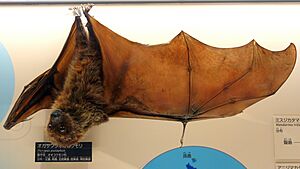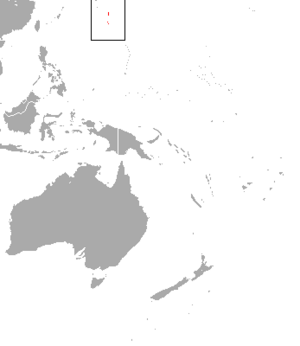Bonin flying fox facts for kids
Quick facts for kids Bonin flying fox |
|
|---|---|
 |
|
| Conservation status | |
| Scientific classification | |
| Genus: |
Pteropus
|
| Species: |
pselaphon
|
 |
|
| Bonin flying fox range | |
The Bonin flying fox (Pteropus pselaphon), also called the Bonin fruit bat, is a type of flying fox. These bats belong to the Pteropodidae family. They are special because they live only on four islands in Japan. These islands are Chichijima, Hahajima, North Iwo Jima, and South Iwo Jima. Their natural home is in warm, wet forests. Sadly, their homes are disappearing, which puts them in danger.
Contents
Meet the Bonin Flying Fox
Bonin flying foxes have mostly black and brown fur. Some of their hairs have silver tips, making them look shiny. The skin between their legs, called the uropatagium, is mostly covered in fur on top. About half of it is furry underneath.
Their body fur is smooth. But the fur around their head, neck, and shoulders is a bit frizzy. They also have unique, scroll-shaped nostrils.
Size and Weight
These bats are about 254 millimeters (10 inches) long from their nose to the tip of their tail membrane. Their wings can spread out to about 787 millimeters (31 inches) wide. Their forearms, which are part of their wings, are between 132 and 143 millimeters (5.2-5.6 inches) long. They usually weigh between 403 and 587 grams (14-20 ounces). Young bats, called pups, have forearms shorter than 125 millimeters (4.9 inches). In zoos, these bats can live for at least 16 years.
What Bonin Flying Foxes Eat
Bonin flying foxes are herbivores, meaning they only eat plants. They love to eat fruits from trees like Manilkara and Pandanus. This includes fruits like screw-pine and thatch screwpine.
When they eat fruit, they mostly suck out the juices. They often drop the rest of the fruit. They also eat parts of ornamental plants, like Agave americana. Scientists have even found fern spores in their droppings, meaning they eat ferns too!
Favorite Foods
Their diet is quite varied. They enjoy fruits like soursop, sugar-apples, and pitahaya. They also eat parts of banana plants, including fruits, leaves, and flowers. Other favorites include Indian-almond fruit, Java apple fruit and flowers, and guava fruit.
They also like flowers from plants like traveller's palm and giant white bird of paradise. Citrus fruits are also on their menu, such as key limes, Meyer lemons, pomelos, grapefruit, amanatsu, sweet oranges, and tangerines. They also eat mangos, figs, and Chinese mulberries.
Bonin Flying Fox Behavior
When these bats look for food, they move slowly through the trees. In the summer, they prefer to rest alone. They do not gather in large groups.
However, in the winter, they change their behavior. They form unique, ball-shaped clusters during the day. This helps them stay warm and save body heat. These winter groups can have up to 100 bats! Interestingly, Bonin flying foxes are not very afraid of humans.
Reproduction and Life Cycle
Mating happens often in their winter colonies. In groups with many female bats, scientists have seen up to 27 mating instances in a single day. It is thought that these bats can have babies all year round.
A female bat is pregnant for about 5 to 7 months. After this, she gives birth to one baby, called a pup. Pups are most often seen in August. However, they have also been spotted in February, March, April, and December.
Where Bonin Flying Foxes Live
The Bonin flying fox is one of the northernmost types of flying foxes. They live only on the Bonin Islands in Japan. These islands include Chichijima and Hahajima. They are also found on the Iwo Islands, specifically North Iwo Jima, Iwo Jima, and South Iwo Jima.
Their home is in subtropical areas. The islands where they live often have many steep hills.
Protecting the Bonin Flying Fox
The Bonin flying fox has faced many challenges. In 1994 and 1996, the IUCN listed them as a vulnerable species. This means they were at risk. By 2000, their situation worsened, and they were listed as critically endangered. This is the highest risk category before extinction.
Good news came in 2017 when their status improved slightly. They were then listed as endangered. They are still considered endangered because they live in a very small area. Their habitat is also broken into small pieces. There are fewer than 250 adult bats left.
In 1969, Japan declared this species a Natural Monument. This law made it illegal to catch or hunt them.
The number of bats on Chichijima Island dropped significantly. In 1997, there were about 150 bats. But by 2002, only 65-80 bats were left.
Why They Are in Danger
Several things might be causing their numbers to drop. Some bats get caught in nets used by farmers. Feral cats also hunt them. Scientists also think that other animals, like rats, white-eyes, and honey bees, might be competing with the bats for food and space. These animals are not native to the islands.
Bonin Flying Foxes in Zoos
In the past, some Bonin flying foxes lived at Tama Zoological Park in Tokyo. Two bats died there in 1998 and 1999. It is not clear if any are still kept there today. It is also unknown if there are plans to breed them in zoos to help their population grow.


